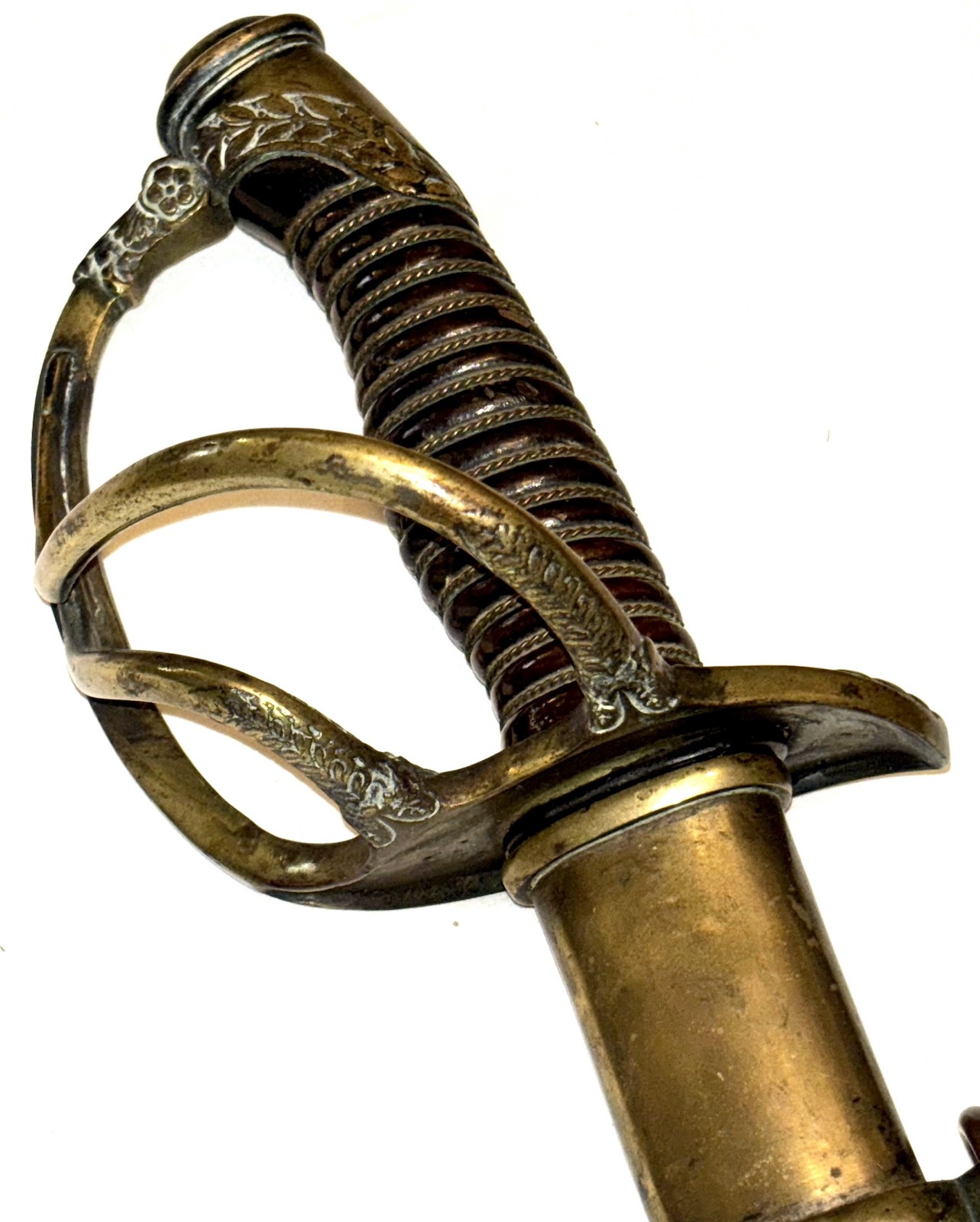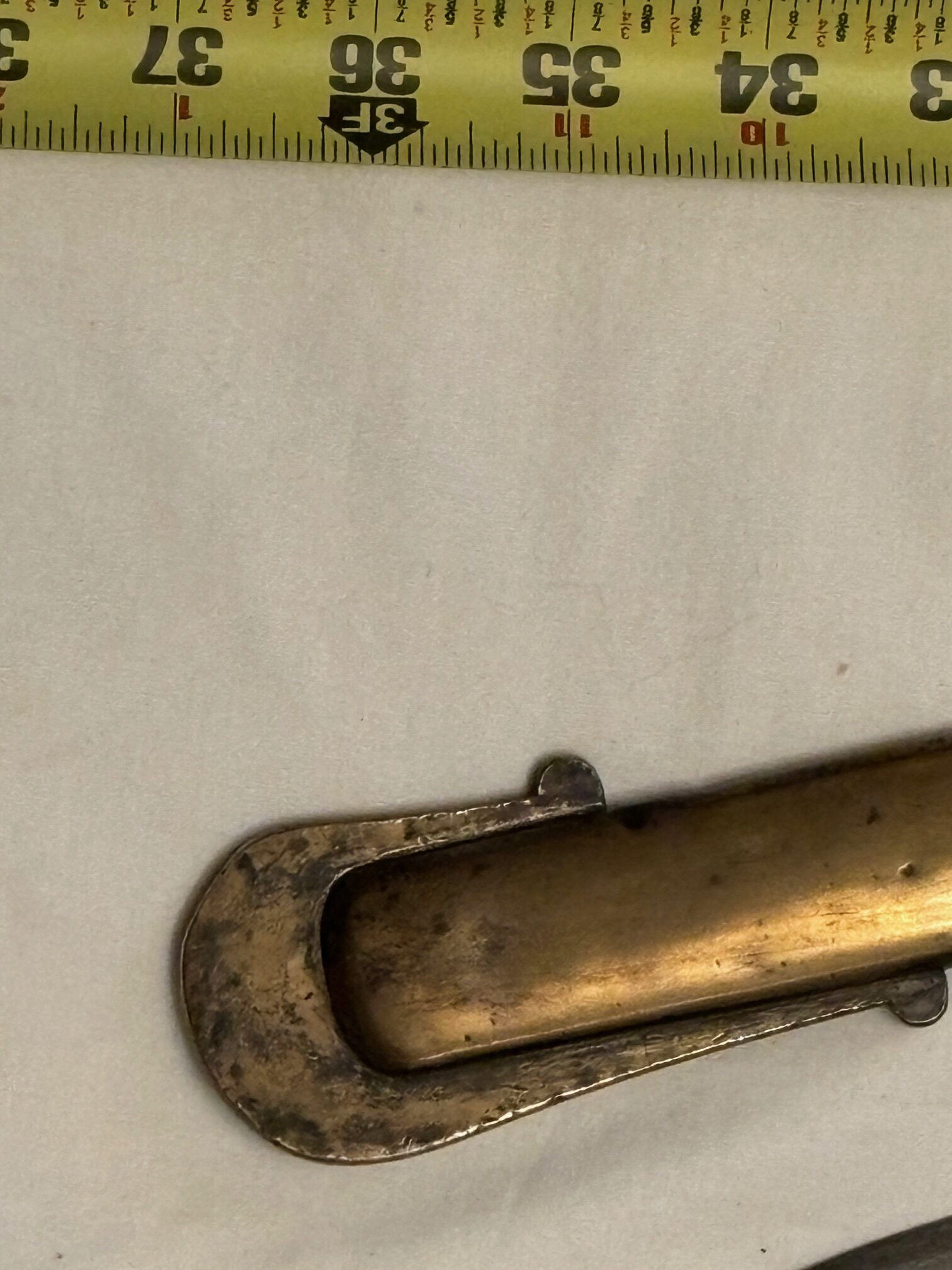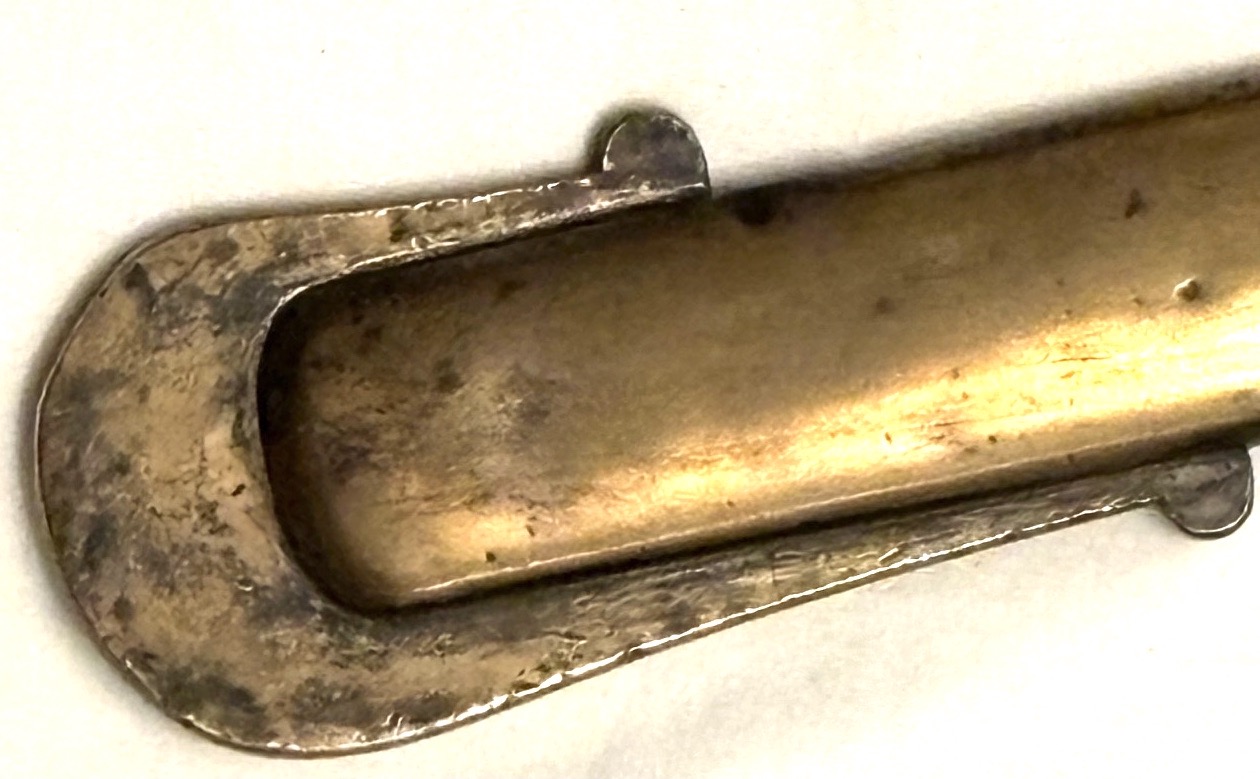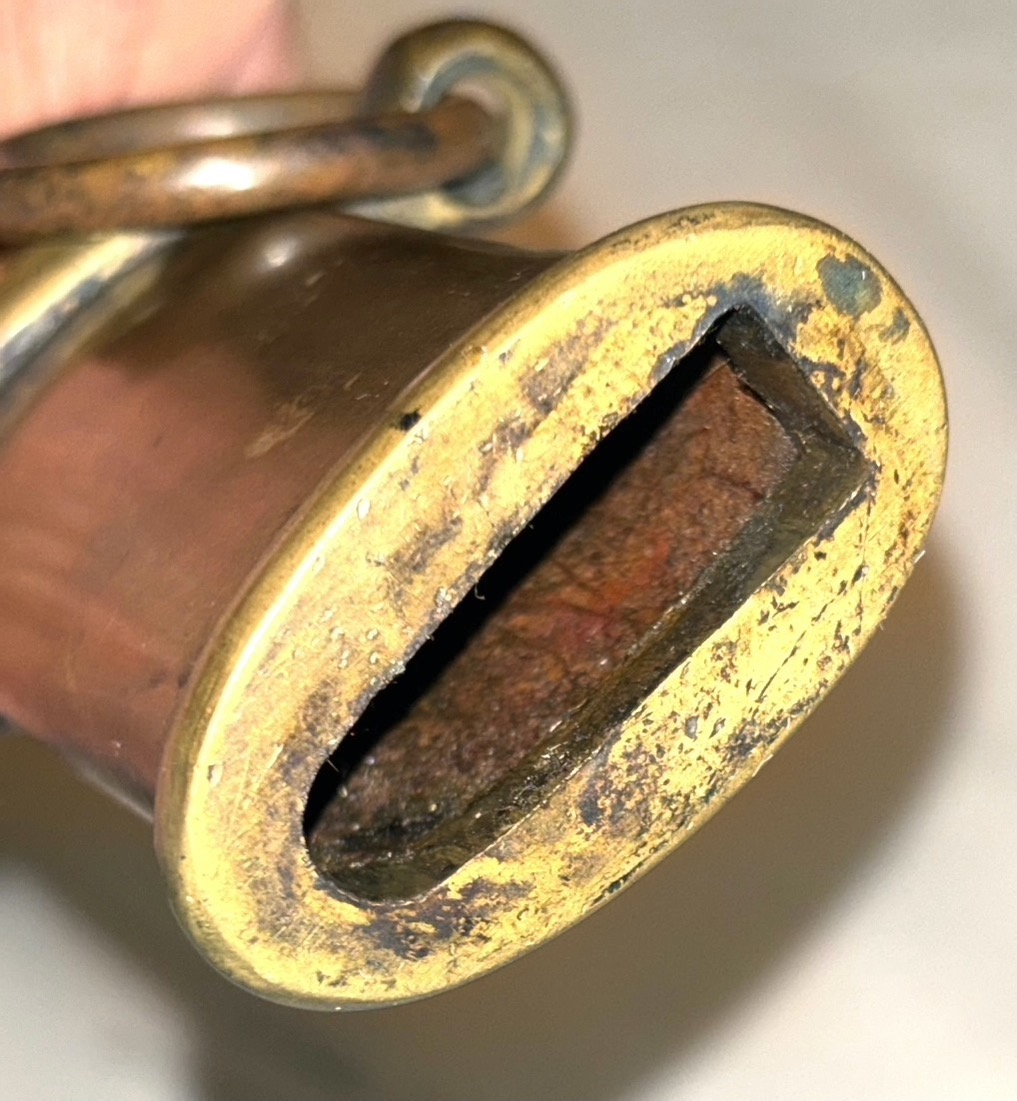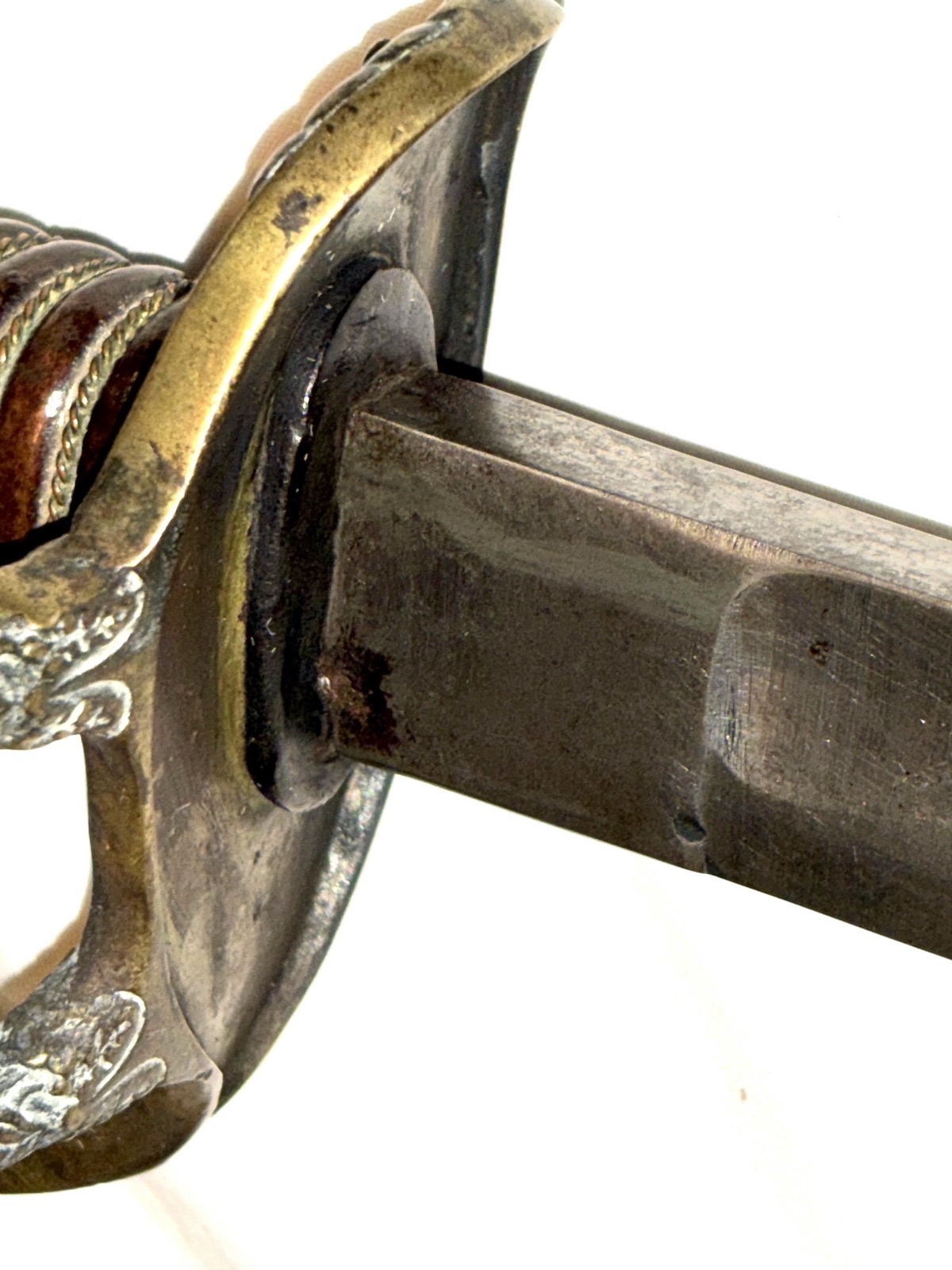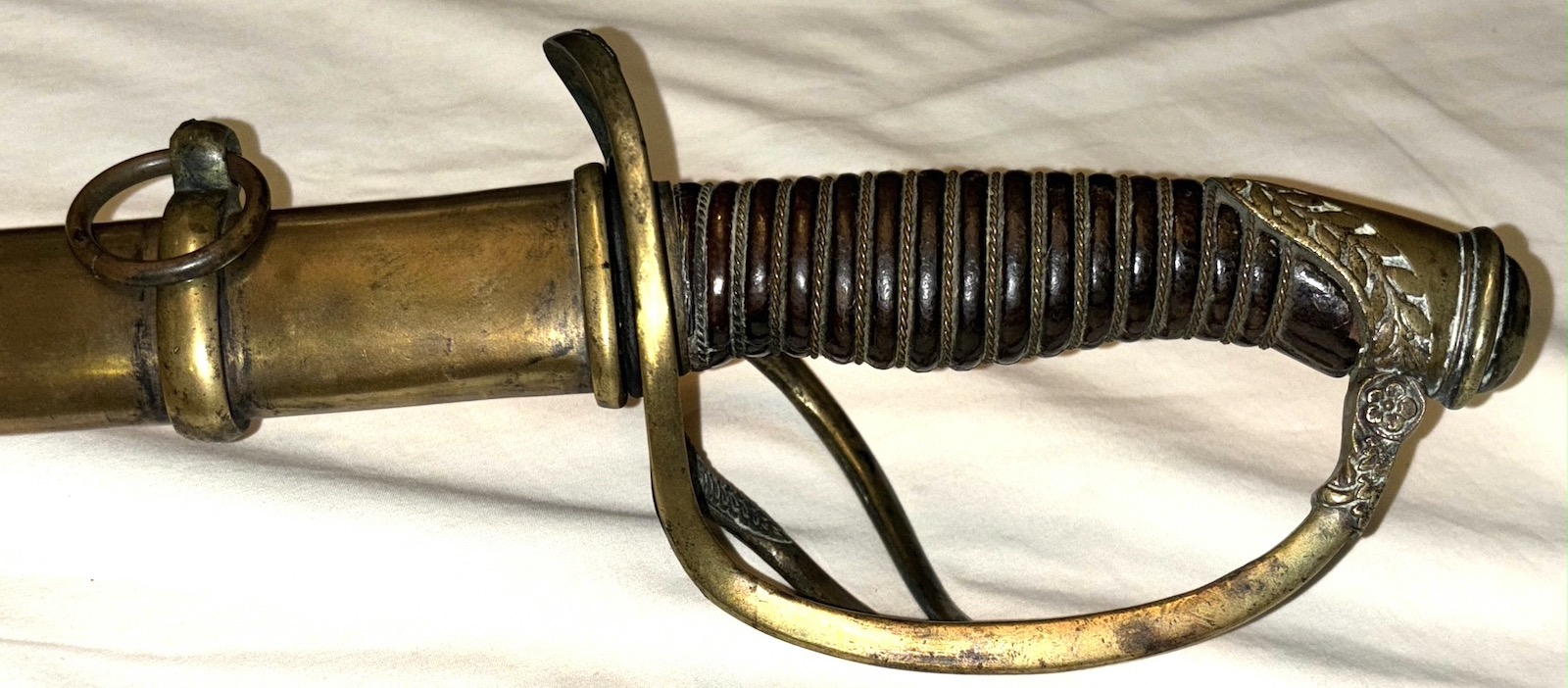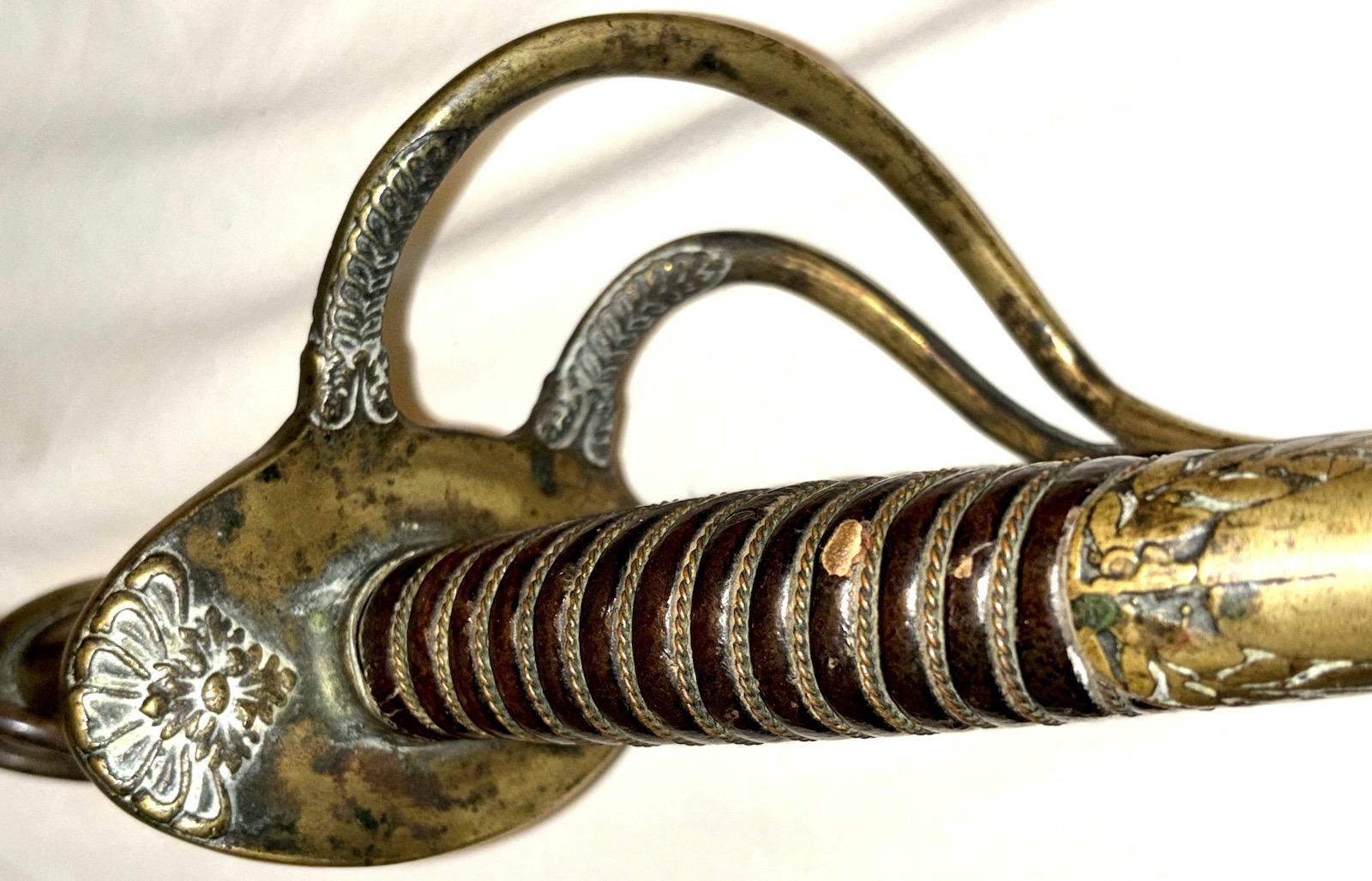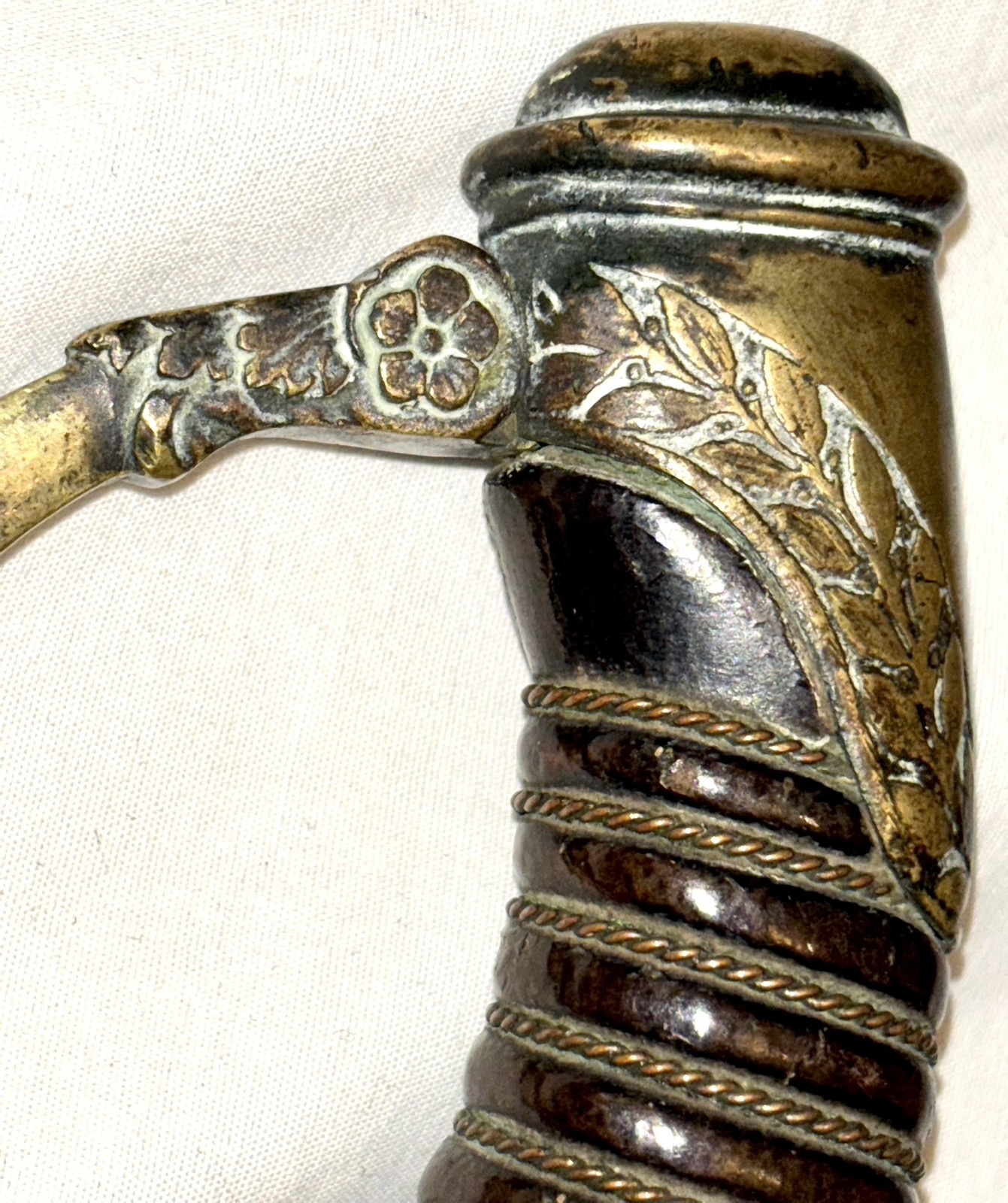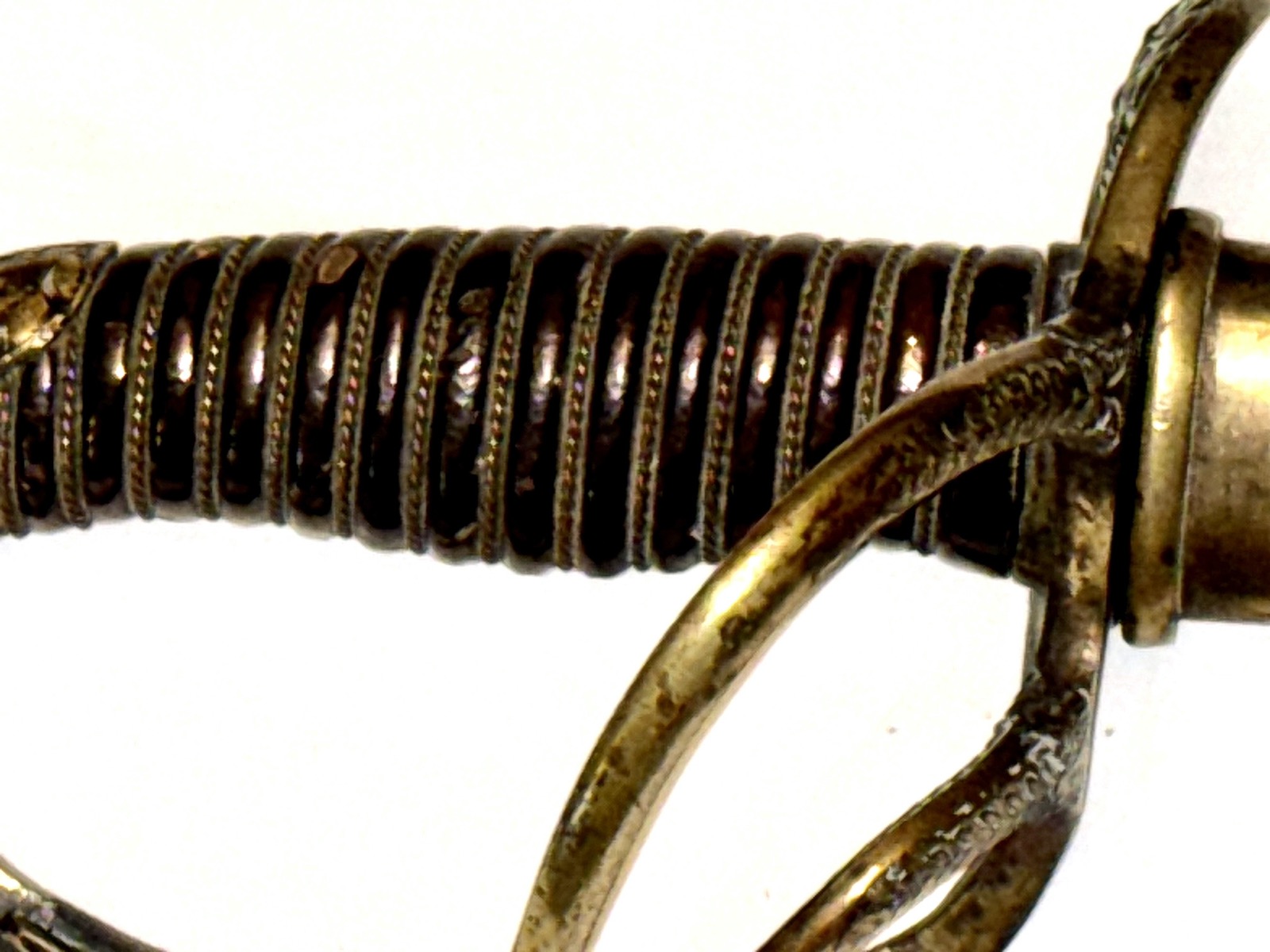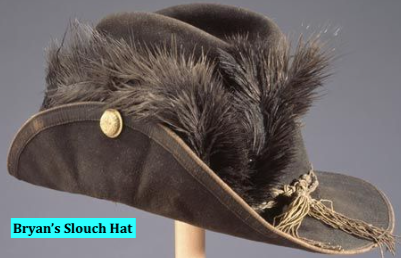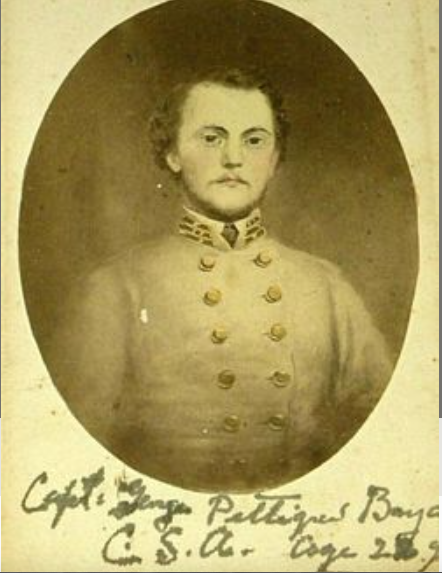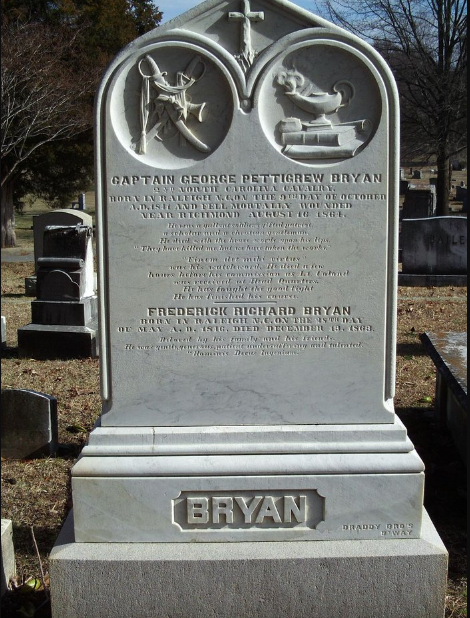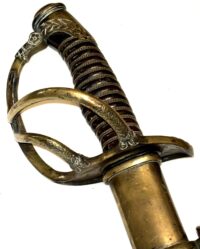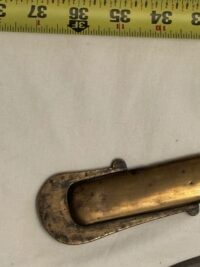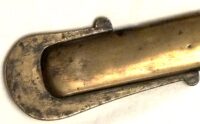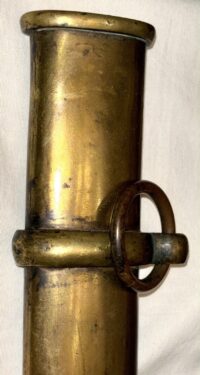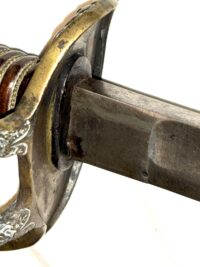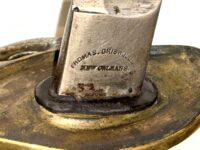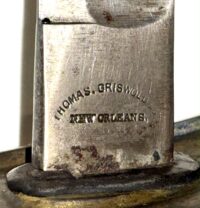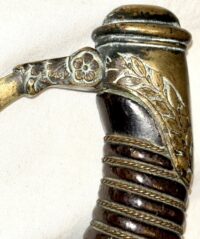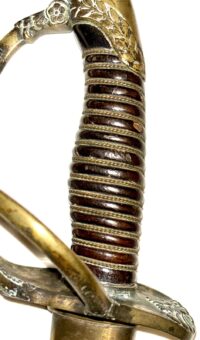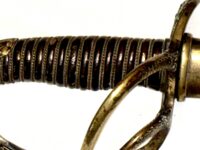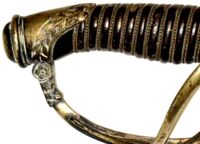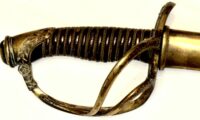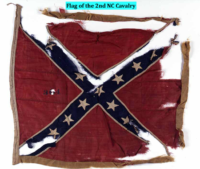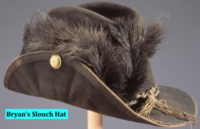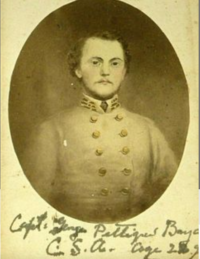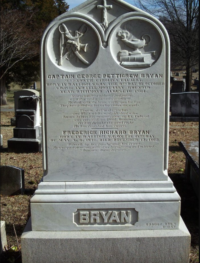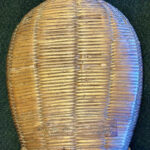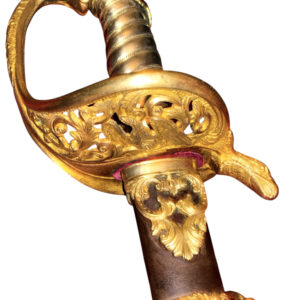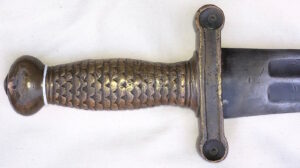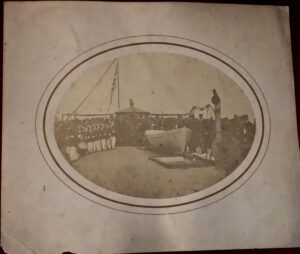Id’d Thomas, Griswold Cavalry Officers’ Saber – Captain George Pettigrew Bryan Commander of Company C, 19th North Carolina Troops (Second Regiment North Carolina Cavalry)
$24,000
NEW PRICING! Id’d Thomas, Griswold Cavalry Officers’ Saber – Captain George Pettigrew Bryan Commander of Company C, 19th North Carolina Troops (Second Regiment North Carolina Cavalry) – This saber is an extremely rare example of a Thomas Griswold & Company of New Orleans, Cavalry Officers’ saber; the saber was the possession of Captain George Pettigrew Bryan, Co. C, 2nd NC Cavalry. The saber is a cavalry officer’s model by Thomas Griswold, New Orleans, made in the style of the U.S. Model 1840 Heavy Cavalry saber; the Griswold stamping clearly appears on the ricasso of the saber. The saber remains in superior condition, retaining an excellent blade; the grip exhibits its full, original leather and wire wrap. The scabbard is brass, as is the hilt which exhibits numerous floral motifs. According to Gordon Jones’ seminal work “Confederate Odyssey: The George W. Wray, Jr. Civil War Collection at the Atlanta History Center: “…at least 354 cavalry sabers were sold to the state of North Carolina, and a variety of beautiful, finely crafted officers’ swords were provided for private sale.” One must presume that Captain Bryan purchased this saber when he joined his North Carolina cavalry regiment. With the dissolution of the New Orleans firm of Hyde & Goodrich, in 1861, the entity continued operation, renamed as Thomas, Griswold & Co., operating at the corner of Canal and Royal Streets, in New Orleans. The two principal owners of the newly formed company were Henry Thomas, Jr. and A. B. Griswold. Although Griswold would manufacture a wide range of military supplies, the firm was best known for their high-quality swords, sabers and cutlasses. Indeed, Griswold’s edged weapons were considered some of the most finely crafted in the South, during the war. Thomas, Griswold & Company produced and imported military materiel for the Confederacy, as well. Comparable to many southern arms and materiel manufacturers, Thomas, Griswold & Company utilized, as prototypes, Federal arms to provide models for their products as exemplified in the style of this saber. The New Orleans entity’s success was short-lived, as Union Naval forces captured New Orleans on April 25, 1862, thereby ending their brisk business by seizing the South’s largest port city. In response to the capture of New Orleans, Griswold would move production to the state of Georgia; therefore, swords stamped with the Griswold name, made in New Orleans are markedly more desirable on the collectors’ market. This example is clearly stamped on the ricasso:
“Thomas Griswold & Co.
New Orleans”
There are several notable characteristics of the company’s products; the first is that the blade is highly unusual for a Confederate made sword – it has a stopped fuller as a result of the manufacturers having acquired the necessary equipment and skills in the pre-war years; additionally, the high quality scabbard is made entirely of brass, from throat to drag. Of added interest is that the drag on this sword was attached in an “upside down” position, in the period of manufacture. The provenance of this sword is of great significance – it was the edged weapon of **George Pettigrew Bryan, an officer in the 2nd North Carolina cavalry; he would be killed in action, in August, 1864, outside of Richmond, Virginia. We have had other Griswold sabers, but this example is, by far, the best, regarding both overall condition and significant provenance and history.
Measurements: OL – 41”(including scabbard); Sword L – 37; Blade L – 34.5”
**George Pettigrew Bryan (1841-1864) was first cousin to General James J. Pettigrew and brother-in-law of General Bryan Grimes. He was the son of prominent congressman and lawyer John Heritage Bryan (1798-1870) and Mary Williams Shepard Bryan (1801-1881). Bryan’s military records indicate that he enlisted as a 2nd lieutenant in the 2nd North Carolina Cavalry (19th State Troops) on September 30, 1861. During his tenure with the 2nd North Carolina Cavalry, Bryan was promoted to lieutenant on July 1, 1862; he was both wounded and captured in action while engaged with Union troops at Upperville, Virginia, June 21, 1863. During his imprisonment, Bryan was promoted to the rank of captain, July 14, 1863. He was exchanged at Point Lookout, Maryland, March 1, 1864, and returned to service. On August 16, 1864, Bryan was killed in action while engaged with Union troops, during a cavalry charge outside Richmond. Bryan attained a place on the North Carolina “Roll of Honor” for his service during the Civil War and is interred in Oakwood Cemetery, Raleigh, North Carolina.
Provenance: On June 16, 1997, Bryan’s Thomas, Griswold, cavalry officer’s saber was sold to Will Gorges, noted long time, respected dealer, by William Bryan Thomson, a descendant of George Pettigrew Bryan’s brother, Henry Ravenscroft Bryan, Jr. A bill of sale accompanies the saber, duly notarized, which provides the pertinent facts surrounding the sale and the establishment of its original, war period ownership by George Pettigrew Bryan. An accompanying letter by Mr. Gorges describes his knowledge of the saber as early as 1992, and numerous subsequent contacts he had with Mr. Thomson.
Bryan’s Richmond Depot shell jacket is held by the North Carolina Division of Archives and History; his officer’s slouch hat is held by the NC Museum of History.
Capt George Pettigrew Bryan VETERAN
BIRTH
9 Oct 1841
DEATH
16 Aug 1864 (aged 22)
BURIAL
Raleigh, Wake County, North Carolina, USA
2nd North Carolina Cavalry, Co. G. C.S.A.
The 2nd North Carolina Cavalry Regiment commissioned or enlisted 1,439 men during the Civil War. Sixty-three were killed or mortally wounded and 151 died of disease. Two hundred fifty-six became prisoners of war, of whom 17 died in captivity. Seventy-one were disabled, and 30 deserted.
2nd North Carolina Cavalry Regiment
19th North Carolina State Troops
The 2nd North Carolina Cavalry Regiment commissioned or enlisted 1,439 men during the Civil War. Sixty-three were killed or mortally wounded and 151 died of disease. Two hundred fifty-six became prisoners of war, of whom 17 died in captivity. Seventy-one were disabled, and 30 deserted.
| 1861 | |
| August 30 | The 2nd North Carolina Cavalry Regiment was organized at Kittrell’s Springs at Camp Clark under the command of Colonel Samuel B. Spruill, Lieutenant Colonel William G. Robinson, and Major John W. Woodfin. The regiment enlisted for the duration of the war. Regimental officers were appointed by the governor until 1862, when a law was passed allowing troops to elect their company officers.
Company A – Cherokee County – Captain George W. Hayes The state also provided mounts to the privates of the regiment. |
| October | The regiment was posted in three commands: Companies D, E, F, I &, K with Colonel Spruill and Major Woodfin to Hertford, then Edenton. Companies B & G (Second Squadron) under Lieutenant Colonel Robinson to Washington, N.C. Companies C & H (Third Squadron) under Captain Boothe to the Neuse River below New Bern. Company A at Asheville. |
| December | All of the regiment except Companies B & G came together at New Bern. Assigned to District of the Pamlico, Department of North Carolina. Companies F & K received their horses so that the whole regiment was mounted. But they were not armed, the men finding whatever weapons they could. |
| 1862 | |
| March | Assigned to French’s Brigade, District of the Pamlico, Department of North Carolina. Governor Clark complained to the Confederate Government that the regiment had never been provided with weapons despite having been in service for six months. It would eventually equip itself with captured weapons in Virginia. |
| March 15 | Battle of New Bern |
| Late March | Went into Camp at Wise’s Fork. The regiment’s companies were all together for the first time. |
| April-September | Assigned to Ransom’s Brigade, Department of North Carolina
The regiment picketed Burnside’s troops through the summer. Lieutenant Colonel Robinson was wounded and captured. Captain Turner of Company K was badly wounded and disabled. |
| April 13 | Gillett’s Farm |
| April | Colonel Spruill resigned. |
| April | Tuscarora Depot |
| May 15 | Foscue’s Farm
Men from Company A and K skirmished were attacked by strong Federal forces, losing 1 man killed, 6 men wounded, and 2 men captured. |
| May 16 | Pollocksville |
| June 5 | Colonel Solomon Williams (West Point Class of 1858) transferred from the 12th North Carolina Infantry to take command of the regiment. |
| July 28 | French’s |
| August 31 | Plymouth
Company K |
| September 6 | Washington
Companies C & K. One man was killed. Captain Boothe was badly wounded and disabled from service. |
| September | Assigned to Chambliss’ Command, Department of North Carolina and Southern VirginiaMajor Woodfin resigned. Captain C. M. Andrews of Company B was promoted to major. |
| October | Moved to Virginia and assigned to W.H.F. Lee’s Brigade, Cavalry Division, Army of Northern Virginia |
| December 13 | Battle of Fredericksburg |
| December 14 | Colonel Williams was temporarily detached to preside over a court-martial. Major Andrews would command the regiment until May 8. |
| December 27-29 | Raid on Dumfries and Fairfax Station
One man was captured. |
| 1863 | |
| April-May | Stoneman’s Raid |
| May 1-4 | Battle of Chancellorsville
Six men were captured. |
| May 8 | Major Andrews left on sick furlough. Lieutenant Colonel Payne of the 4th Virginia Cavalry temporarily took command of the regiment. |
| June 1 | The regiment’s roster was:Colonel Solomon Williams No lieutenant colonel, as William G. Robinson was still a Federal prisoner. Major Clinton M. AndrewsCompany A – Captain J. V. B. Rogers Company B – Captain S. J. Andrews Company C – Captain James M. Wynn Company D – Captain James W. Strange Company E – Captain B. W. Atkinson Company F – Captain P. A. Tatum Company G – Captain M. L. Eure Company H – Captain R. H. Reese Company I – Captain D. O. Bryan Company K – Captain W. A. Graham, Jr. |
| June 8 | Stuart’s Cavalry Review |
| June 9 | Battte of Brandy Station, Beverly Ford
The regiment lost 4 men killed, 17 wounded and 9 captured. Colonel Williams was killed, shot through the head while rallying his men for a charge. Captain S. Jay Andrews of Company B lost his foot and Lieutenant J. G. Blassingame of Company F was mortally wounded. Captain Strange of Company D took command of the regiment. |
| June 19 & 21 | Middleburg & Upperville
Six men were killed, eight wounded, and five were captured. Lieutenant Cole of Company I was killed, and Lieutenant Bryan of Company G was wounded and captured. Lieutenant Holden of Company F had his arm broken. |
| June 30 | Battle of Hanover, Pennsylvania
Lieutenant Colonel William H.F. Payne commanded the regiment. He was wounded and captured. Captain William A. Graham took command until he was wounded. Lieuteant Joseph Baker of Company D took command as senior officer. Four men were wounded and 18 were captured. |
| July 1-3 | Battle of Gettysburg
The regiment brought 145 men to the battlefield under Lieutenant Joseph Baker of Company D. Two men were wounded and four captured. From the monument to W.H.F. Lee’s Brigade at Gettysburg: July 3. The Brigade reached here about noon and took an active part in the fight until it ended. Some of the men serving as sharpshooters in the vicinity of the Rummel Barn but most of the Command participating in the charges made by the Cavalry during the afternoon. It left the field after nightfall. |
| July 12 | Hagerstown
One man was captured. |
| July 14 | Falling Waters
Four men were captured. |
| September | Assigned to Baker’s Brigade, Hampton’s Division, Cavalry Corps, Army of Northern Virginia |
| October 10 | Russel’s Ford and James City |
| October 11 | Culpeper Court House |
| October 14 | Auburn Mills
One man was captured. |
| October 15 | Bristoe Station
One man was wounded. |
| October 19 | Buckland |
| November 13 | Lieutenant William P. Roberts was promoted to captain. |
| November 29 | Parker’s Store |
| 1864 | |
| February-March | Kilpatrick-Dahlgren Raid |
| April | Assigned to Gordon’s’s Brigade, W.H.F. Lee’s Division, Cavalry Corps, Army of Northern Virginia. Captain William Roberts was promoted to major. |
| May 5-6 | Battle of the Wilderness
One man was captured. |
| May 11 | Goodall’s Tavern & Ground Squirrel Church |
| May 24 | Wilson’s Wharf |
| May 27 | Hanover Court House |
| May 30 | Haw’s Shop |
| June 1 | Ashland |
| June | Malvern Hill |
| June 24 | Nantz’s Shop |
| June | Siege of Petersburg
Major William Roberts was promoted to colonel. |
| June | Crenshaws |
| June | The Rocks |
| June 21 | Davis Farm
Two men were captured. |
| June 23 | Black and Whites |
| June 28 | Sappony Church |
| July 17 | Herring Creek |
| July 27 | New Market Road |
| July 27-29 | Darbytown & Strawberry Plains |
| August 15 | Deep Bottom
One man was killed, one missing and two captured. |
| August | White’s Tavern
One man was wounded. |
| August | White Oak Swamp |
| August 22-25 | Reames Station
One man was wounded. |
| September 16 | Beef Steak Raid |
| September 27 | McDowell’s Farm |
| Sepember 30 | Jones’ Farm |
| October 2 | Harman Road |
| October | Boisseau’s Farm |
| October | Gravelly Run |
| October | Hargrove’s Road |
| October 27-28 | Boydton Plank Road |
| December 8 | Belfield |
| 1865 | |
| February 23 | Colonel Roberts was promoted to brigadier general. |
| March 31 | Dinwiddie Court House |
| April 1 | Battle of Five Forks
The regiment lost 1 man killed, four wounded, and ten captured. |
| April 3 | Namozine Curch |
| April 4 | Amelia Court House
Three men were captured. |
| April 9 | Appomattox Court House
The regiment surrendered only 7 men. |

